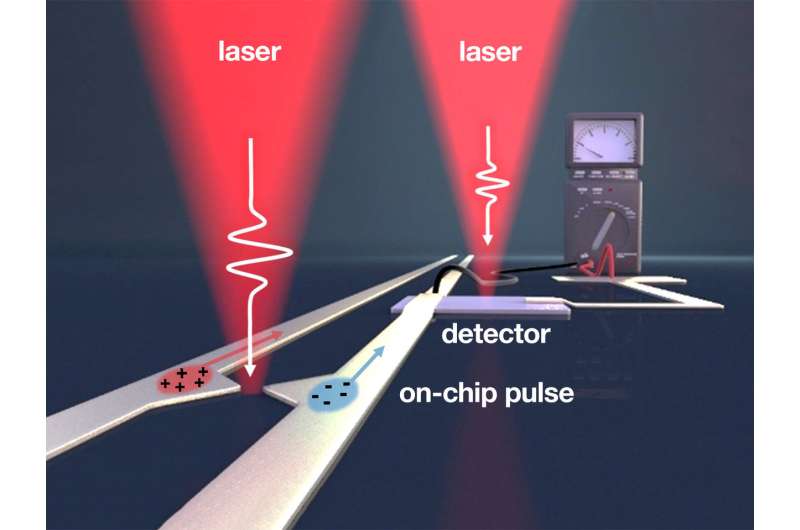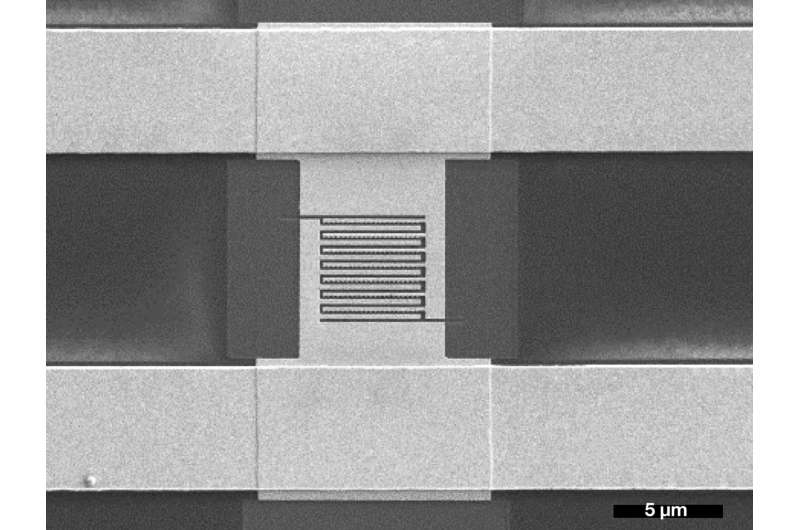A team headed by the TUM physicists Alexander Holleitner and Reinhard Kienberger has succeeded for the first time in generating ultrashort electric pulses on a chip using metal antennas only a few nanometers in size. Pulses of femtosecond length from the pump laser (left) generate on-chip electric pulses in the terahertz frequency range. With the right laser, the information is read out again. Credit: Christoph Hohmann / NIM, Holleitner / TUM
A team headed by the TUM physicists Alexander Holleitner and Reinhard Kienberger has succeeded for the first time in generating ultrashort electric pulses on a chip using metal antennas only a few nanometers in size, then running the signals a few millimeters above the surface and reading them in again a controlled manner. The technology enables the development of new, powerful terahertz components.
Classical electronics allows frequencies up to around 100 gigahertz. Optoelectronics uses electromagnetic phenomena starting at 10 terahertz. This range in between is referred to as the terahertz gap, since components for signal generation, conversion and detection have been extremely difficult to implement.
The TUM physicists Alexander Holleitner and Reinhard Kienberger succeeded in generating electric pulses in the frequency range up to 10 terahertz using tiny, so-called plasmonic antennas and running them over a chip. Researchers call antennas plasmonic if their shape amplifies the light intensity at the metal surfaces.
The asymmetrical shape of the antennas is important. One side of the nanometer-sized metal structures is more pointed than the other. When a lens-focused laser pulse excites the antennas, they emit more electrons on their pointed side than on the opposite flat ones. An electric current flows between the contacts—but only as long as the antennas are excited with the laser light.
"In photoemission, the light pulse causes electrons to be emitted from the metal into the vacuum," explains Christoph Karnetzky, lead author of the Nature study. "All the lighting effects are stronger on the sharp side, including the photoemission that we use to generate a small amount of current."
Electronmicroscopic image of the chip with asymmetric plasmonic antennas made from gold on sapphire. Credit: A. Holleitner / TUM
The light pulses lasted only a few femtoseconds. The electrical pulses in the antennas were correspondingly short. Technically, the structure is interesting because the nano-antennas can be integrated into terahertz circuits a mere several millimeters across. In this way, a femtosecond laser pulse with a frequency of 200 terahertz could generate an ultra-short terahertz signal with a frequency of up to 10 terahertz in the circuits on the chip, according to Karnetzky.
The researchers used sapphire as the chip material because it cannot be stimulated optically and, thus causes no interference. With an eye on future applications, they used 1.5-micron wavelength lasers deployed in traditional internet fiber-optic cables.
Holleitner and his colleagues made yet another amazing discovery: Both the electrical and the terahertz pulses were non-linearly dependent on the excitation power of the laser. This indicates that the photoemission in the antennas is triggered by the absorption of multiple photons per light pulse.
"Such fast, nonlinear on-chip pulses did not exist hitherto," says Alexander Holleitner. Utilizing this effect he hopes to discover even faster tunnel emission effects in the antennas and to use them for chip applications.
More information: Christoph Karnetzky et al, Towards femtosecond on-chip electronics based on plasmonic hot electron nano-emitters, Nature Communications (2018). DOI: 10.1038/s41467-018-04666-y
Journal information: Nature , Nature Communications
Provided by Technical University Munich
























